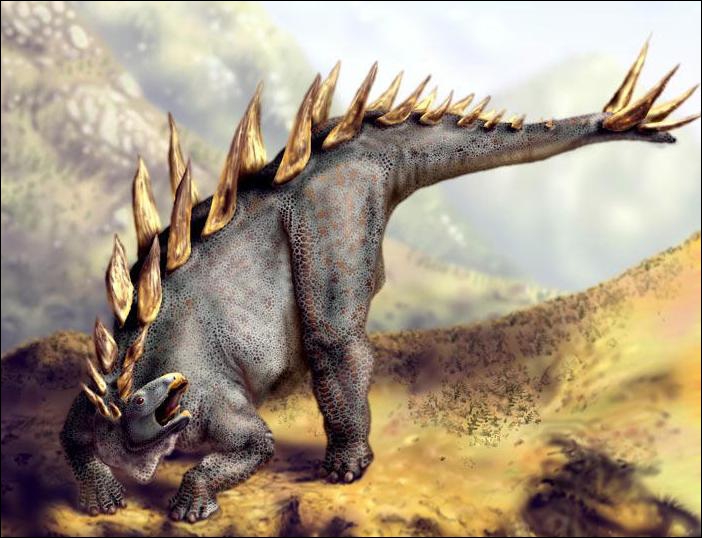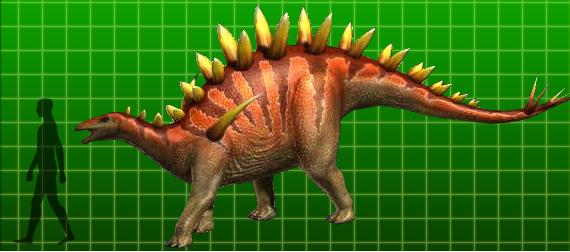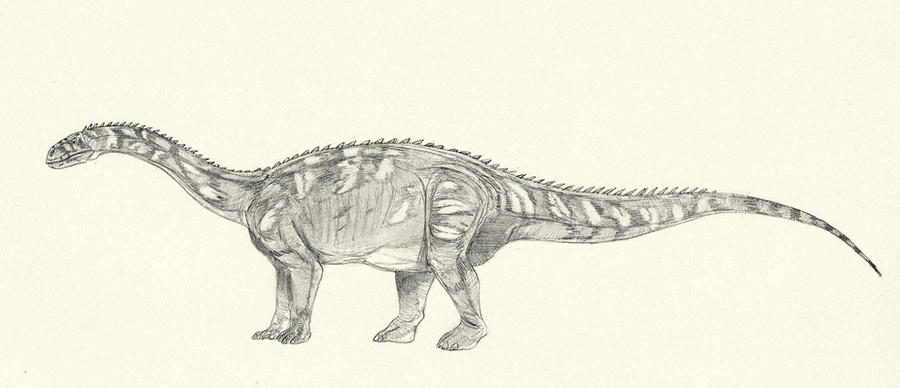[Recent Entries][Archive][Friends][User Info]
January 24th, 2013
| January 24th, 2013 | |
|---|---|
| 06:11 pm [industrialterro] [Link] |
Tuojiangosaurus Туоджиэнгозавр (Tuojiangosaurus, кит. 沱江龙 (tuójiānglóng), дословно — «ящер с реки Туо») — род динозавров позднего Юрского периода с единственным видом — Tuojiangosaurus multispinus. Достигал длины в 7 метров, высоты в 2 метар и веса в более чем 4 тонны. На хвосте и плечах имел колючки. Физически идентичен североамериканскому стегозавру, вероятно, являясь его китайской разновидностью или популяцией. Обнаружен в провинции Сычуань, КНР. Скелеты выставлены в нескольких музеях, в том числе — в Лондоне. Этот динозавр, живший 157-154 млн. лет назад, был открыт в 1977 году. Внешне этот динозавр был очень похож на американского стегозавра: у него были маленькая голова, клюв, как у попугая, передние лапы были меньше задних, из-за чего спина была покатой, хвост был снабжён четырьмя большими шипами. Его спинные платины отличались по форме от аналогичных пластин стегозавра: они были больше похожи на большие плоские шипы, чем на стандартные пластины стегозаврид. Зубы маленькие, грубо зазубренные, с вертикальными бороздками. Туоджиэнгозавры жили небольшими группами, возле больших водоёмов, где в изобилии росли папоротники, которыми питались эти ящеры. Tuojiangosaurus (meaning "Tuo River lizard") is a genus of stegosaurid dinosaur from the Late Jurassic Period, recovered from the Upper Shaximiao Formation of what is now Sichuan Province in China. Physically similar to the North American Stegosaurus, Tuojiangosaurus is the best understood of the Chinese stegosaurids. It was around 7 metres (23 ft) long and 2 metres (6.6 ft) high, with a postulated weight of around 4 tonnes (4.4 short tons). The type and only species, T. multispinus, was named in 1977 (exactly a hundred years after Stegosaurus) on the strength of two specimens, one over half complete. Like Kentrosaurus, Tuojiangosaurus had two rows of pointed plates along the spine, which became taller over the hip region. It also had two outward-pointing spikes on each side of the end of the tail, angled at approximately 45 degrees to the vertical. In stegosaurids, this spike arrangement has become affectionately known as the "thagomizer". It also had the typical narrow head, bulky body, and low teeth of other stegosaurids. Because it lacked the tall spines for muscle attachment found on the vertebrae of Stegosaurus, it was probably unable to rear up on its hind legs like that animal. This suggests that it would have eaten low-lying, ground vegetation. A mounted skeleton of Tuojiangosaurus multispinus is on display at the Municipal Museum of Chongqing. In addition, a mounted cast is on display at the Natural History Museum, in London.
Репродукции (1, 2, 3, 4, 5, 6, 7, 8):
( Read More ) Размеры тела в сравнении с человеком:
Ископаемые останки и реплики (1, 2, 3, 4, 5, 6, 7, 8):
( Read More ) Tags: Вымершие рептилии, Юра, авеметатарзалии, архозавроморфы, архозавры, диапсиды, динозавроморфы, динозавры, птицетазовые, стегозавриды, стегозавры, тиреофоры |
| Time | Event |
| 07:09 pm [industrialterro] [Link] |
Vulcanodon Вулканодон (Vulcanodon — «зуб вулкана») — вымерший род динозавров, инфраотряда зауроподов. Вулканодон обладал небольшими размерами, в длину он составлял 6,5 метров, а в высоту был чуть больше человека, около 1,9 метра. Вес его был около 750 килограммов. Обладал длинными, относительно размеров тела, шеей и хвостом. На лапах вулканодона были острые когти, служившие хорошей защитой от атак хищников. Считается, что вулканодоны вели стадный образ жизни. Статус вулканодона, как завропода был установлен в 1975 году на основе формы костей пальцев. Они больше по ширине, чем по высоте, что является характерной чертой завропода, - хотя в данном случае они даже шире, чем у обычных завропод. Кроме того, передние ноги вулканодона длиннее, чем у других завропод. В целом, этот вид имеет строение тела, характерное как для завропод, так и для динозавров из более архаичной группы - прозавропод. В частности строение кости бедра говорит о близости к последним. Помимо этого у вулканодона имелось очень много примитивных черт в строении костей таза, позвонков и конечностей. Возможно, вулканодоны были переходным звеном в эволюции динозавров. Вулканодон был представителем травоядных ящеров осноным рационом которых были листья, трава и другая растительность, которую он заглатывал целиком, так как его зубы не были приспособлены для пережевывания пищи (вместо них с этой задачей справлялись камни-гастролиты, которые эти ящеры регулярно заглатывали). Вулканодон обитал на территории современной Южной Африки (Зимбабве), около 208—201 млн лет назад (Ранняя Юра). Вулканодона описал палеонтолог Майкл Раат из Университета Витватерсранда в 1972 году. Сначала вулканодон был отнесен к группе всеядных прозауроподов, из-за формы зуба, найденного на раскопках. Позже было установлено, что данный зуб принадлежал другому ящеру, который возможно обгладывал тушу вулканодона, после чего Майкл Раат исправил свою же ошибку в описании этого вида. Ошибку он совершил по причине отсутствия головы и шеи у исследуемого скелета. Vulcanodon (meaning "volcano tooth") was a relatively small early sauropod dinosaur genus from the Early Jurassic of southern Africa. About 6.5 metres (20 ft) long, Vulcanodon was herbivorous and had unusually long bones of the first toe and large claws on the inside toes. The type species, V. karibaensis, was formally described by Michael A. Raath of the University of the Witwatersrand, Johannesburg, in 1972 based on fossils found in Rhodesia (now known as Zimbabwe). It was originally believed to be a prosauropod because of the knife-shaped teeth found near its fossils, which fit in with the idea that prosauropods were omnivorous. Scientists now know that the teeth belonged to an unidentified theropod that scavenged on the Vulcanodon's carcass. Vulcanodon is now known to be a true sauropod. The first fossils of Vulcanodon were found sandwiched between volcanic flows, giving it its name. Upon the discovery of the related Tazoudasaurus, both animals were unified in the family Vulcanodontidae. A skull of Vulcanodon has not yet been found, so it must be guessed at. As one of the earliest and basalmost sauropods, Vulcanodon helps to understand the early evolution of this group. Sauropods descend from basal sauropodomorphs (informally called "prosauropods"), which were primitively bipedal (two legged). While Vulcanodon already was fully quadrupedal, its limb proportions were intermediate between those of its prosauropod ancestors and those of later, more derived sauropods. Its limbs were sturdy and column like, and the forelimbs were already proportionally long, reaching 76 % of hindlimb length. Its lower leg, metatarsus, and toes were shortened in comparison to its bipedal ancestors, but still not as short as in later sauropods. The posture of the foot is unclear; it either was digitigrade as in "prosauropods" (only the digits touch the ground) or semiplantigrade as in later sauropods (both the digits and parts of the metatarsals touch the ground). The sacrum was made out four fused sacral vertebrae; "prosauropods" posessed only three sacrals. The pelvis, on the other hand, was relatively primitive, reminiscent of its prosauropod ancestors. Like in other sauropods, the hallux (the first toe of the foot) beared an enlarged claw. Uniquely, the claws of the second and third toe were nail-like and broader than deep, distinguishing Vulcanodon from all other known sauropods.
Размеры тела в сравнении с человеком:
Tags: Вымершие рептилии, Юра, авеметатарзалии, архозавроморфы, архозавры, вулканодонтиды, диапсиды, динозавроморфы, динозавры, завроподоморфы, завроподы, ящеротазовые |
| Time | Event |
| 07:47 pm [industrialterro] [Link] |
Xiaosaurus Xiaosaurus dashanpensis — вид травоядных птицетазовых динозавров, живших в середине юрского периода (между 171,6—161,2 млн лет) в районе современного Китая. Был небольшим двуногим динозавром, с длиной около одного метра. Описан в 1983 году. Голотип, IVPP V6730A, был найден в формации Xiashaximiao, чей возраст является неопределенным: разными исследователями относится к байоцинскому или калловскому веку. Голотип состоит из частичного скелета с фрагментом челюстной кости, двух шейных позвонков, четырех хвостовых позвонков, плечевой кости, части левого бедра и полной правой задней конечности. Второй скелет, IVPP V6730B, обозначен как паратип. Он включает в себя правую бедренную кость, несколько грудных позвонков, два крестцовых позвонка, фаланги пальцев, ребра и два зуба. Точное кладистическое положение данного динозавра является неопределенным, и он помечен как nomen dubium. Баррет в 2005 году отнес его в группу птицетазовых динозавров с пометкой incertae sedis. In 1979 and 1980 two specimens of a small herbivorous dinosaur were discovered during excavations near Dashanpu in Sichuan. In 1983 Dong Zhiming and Tang Zilu named the fossils under the type species Xiaosaurus dashanpensis. The generic name is derived from Chinese xiáo, 曉, "dawn", a reference to the age of the fossil. The specific name refers to Danshanpu. In 1992 Peng Guangzhao renamed Agilisaurus multidens He & Cai 1983 (now Hexinlusaurus) into a second species of Xiaosaurus: Xiaosaurus multidens, but this has not been accepted. Xiaosaurus was a small bipedal animal with an estimated length of one metre. The femur is 11 centimetres (4.3 in) long. The remains are too fragmentary to easily classify the genus. The describers assigned it both to the Fabrosauridae and the Hypsilophodontidae, considering it an evolutionary link between Lesothosaurus and Hypsilophodon. Xiaosaurus has sometimes been considered a nomen dubium and an ornithischian of uncertain affinities, possibly a basal cerapod or marginocephalian. However, Paul Barrett et al. in 2005 concluded it to be provisionally valid, as it possessed a single unique derived trait or autapomorphy: a mediolaterally (seen from the front) straight humerus
Tags: Вымершие рептилии, Юра, авеметатарзалии, архозавроморфы, архозавры, диапсиды, динозавроморфы, динозавры, неорнитискии, птицетазовые |
| Previous Day | 2013/01/24 [Archive] |
Next Day |















